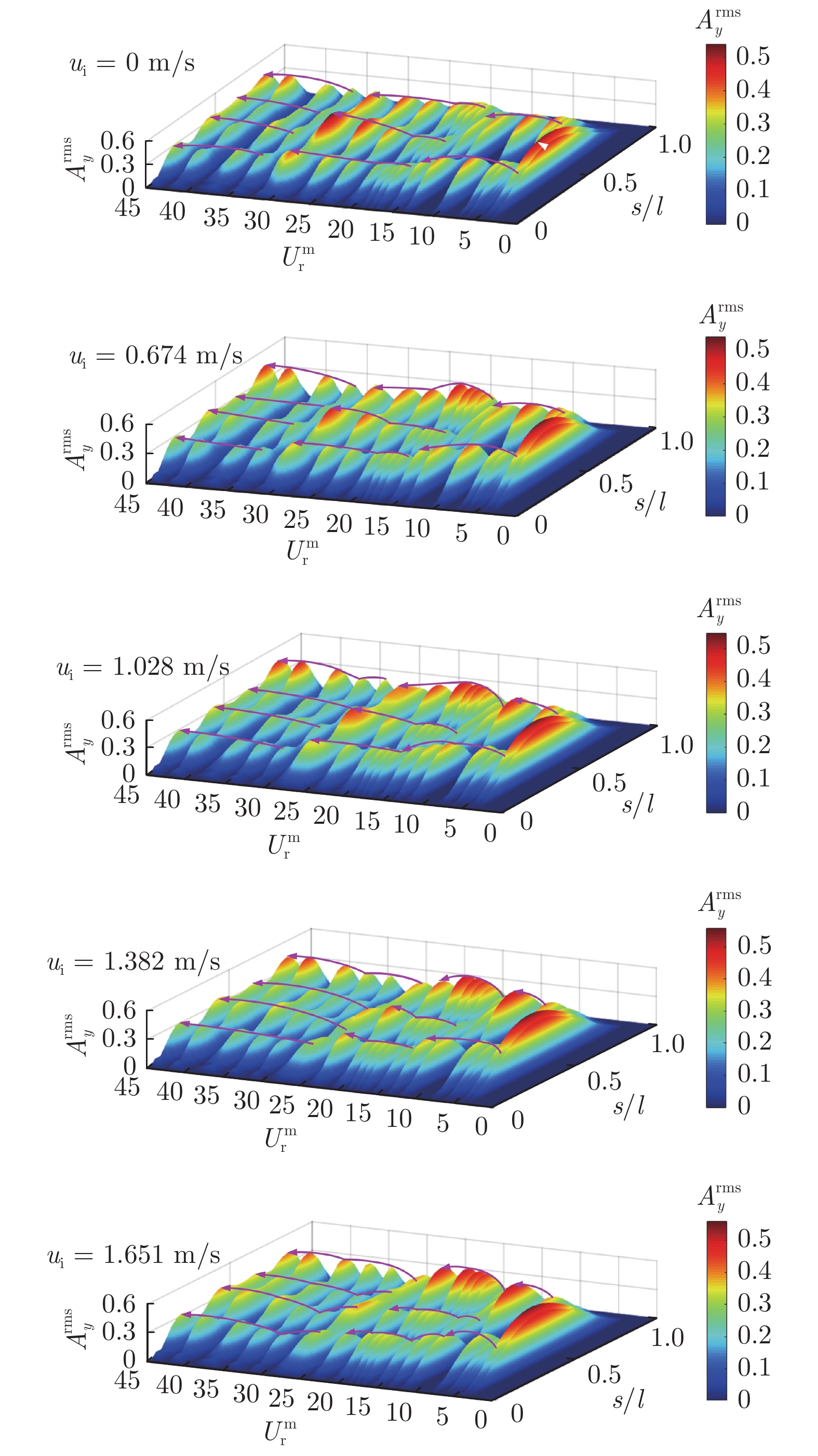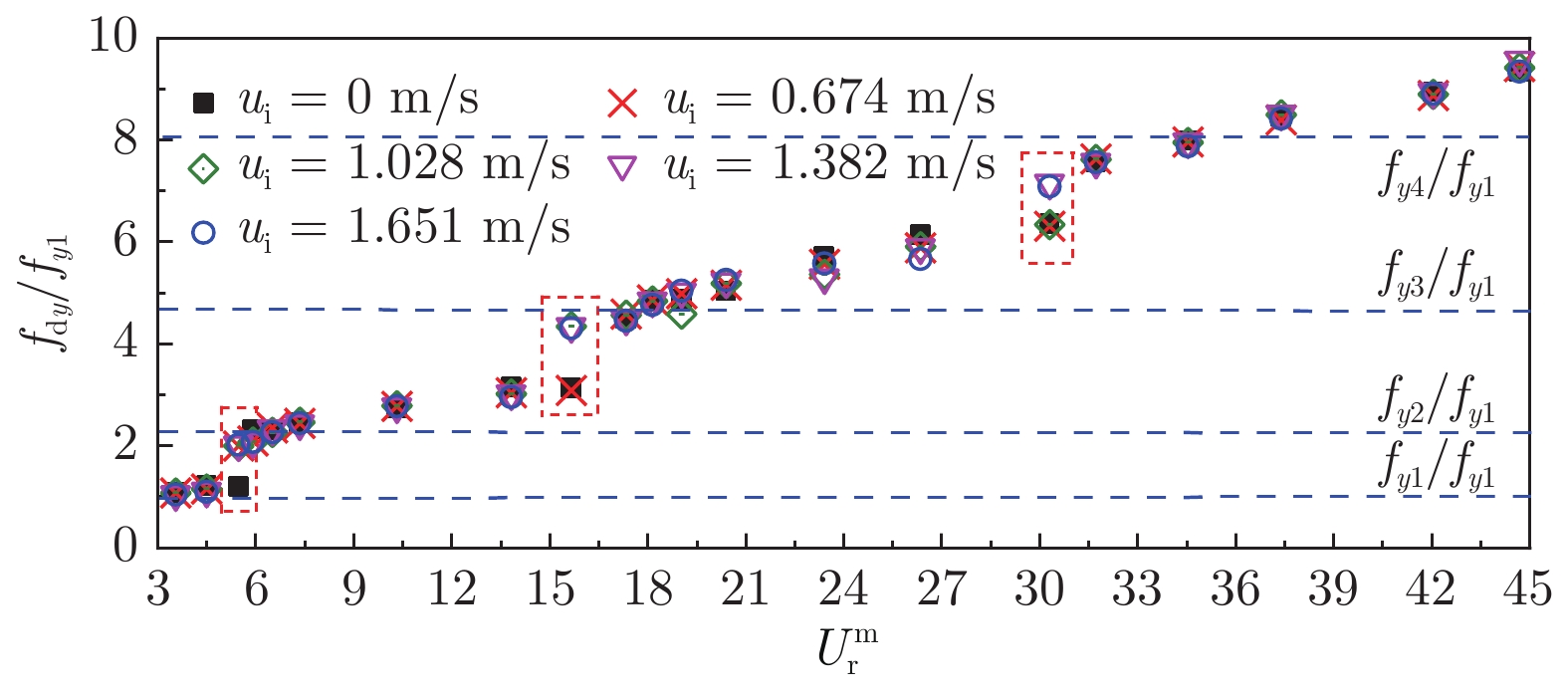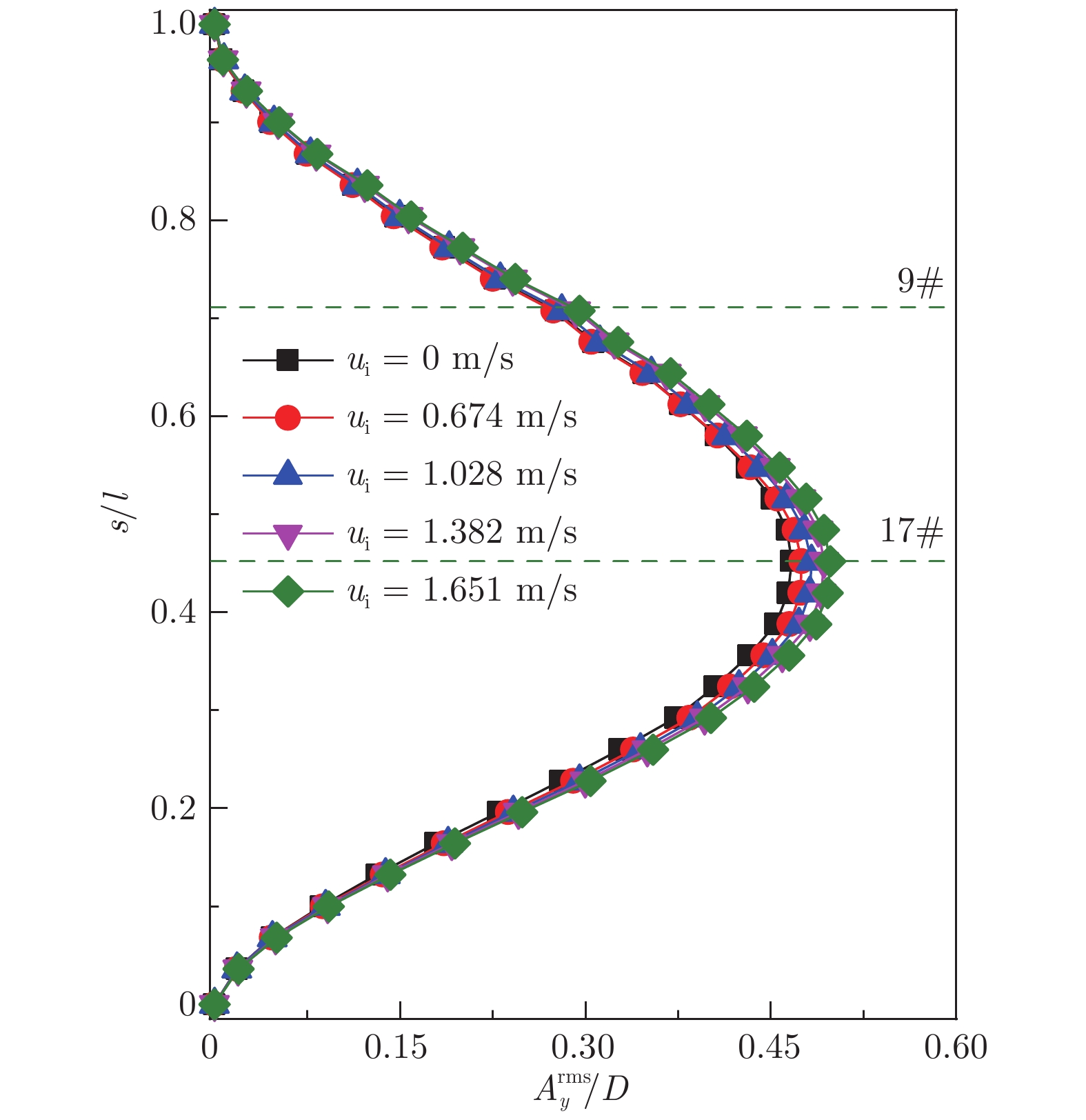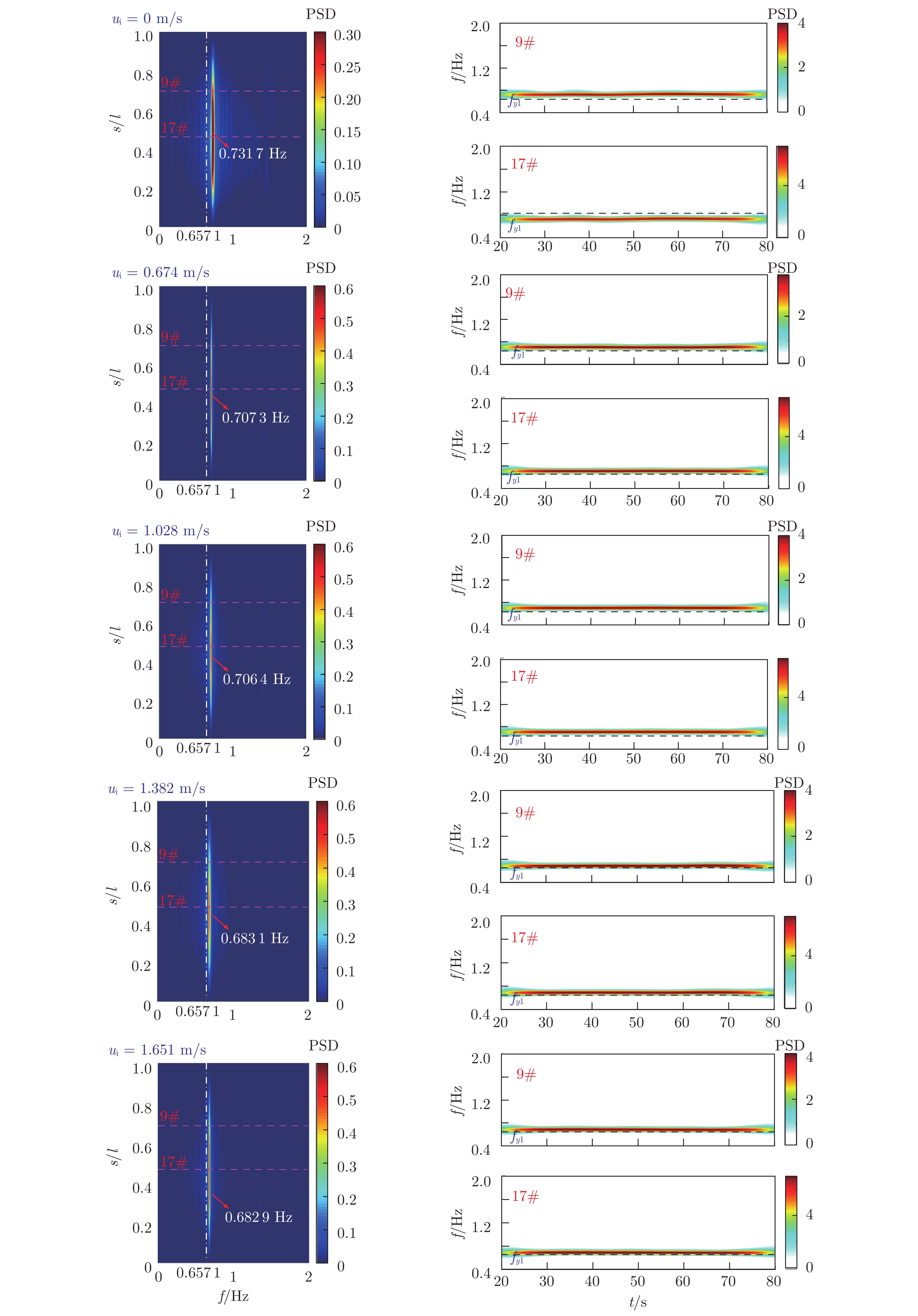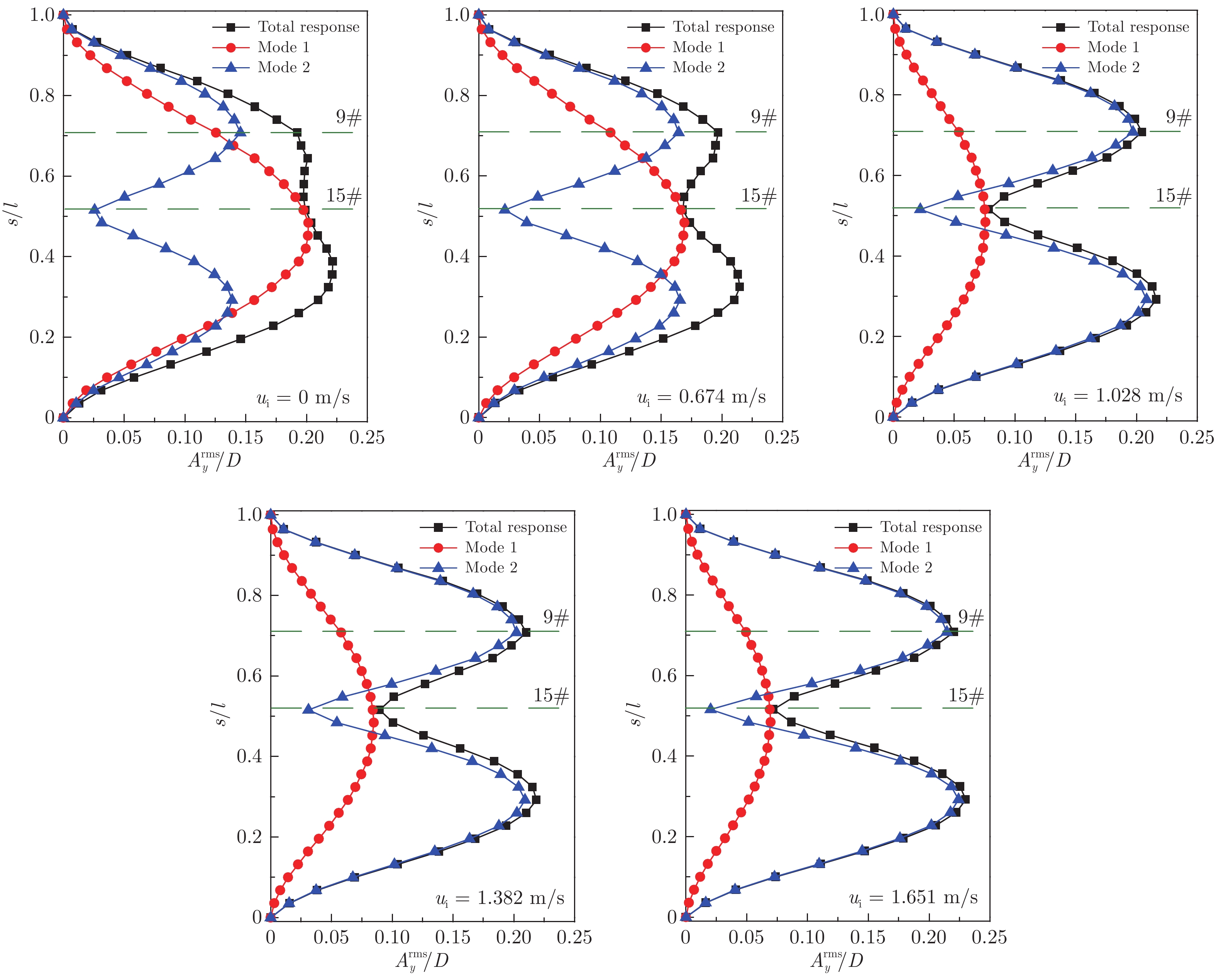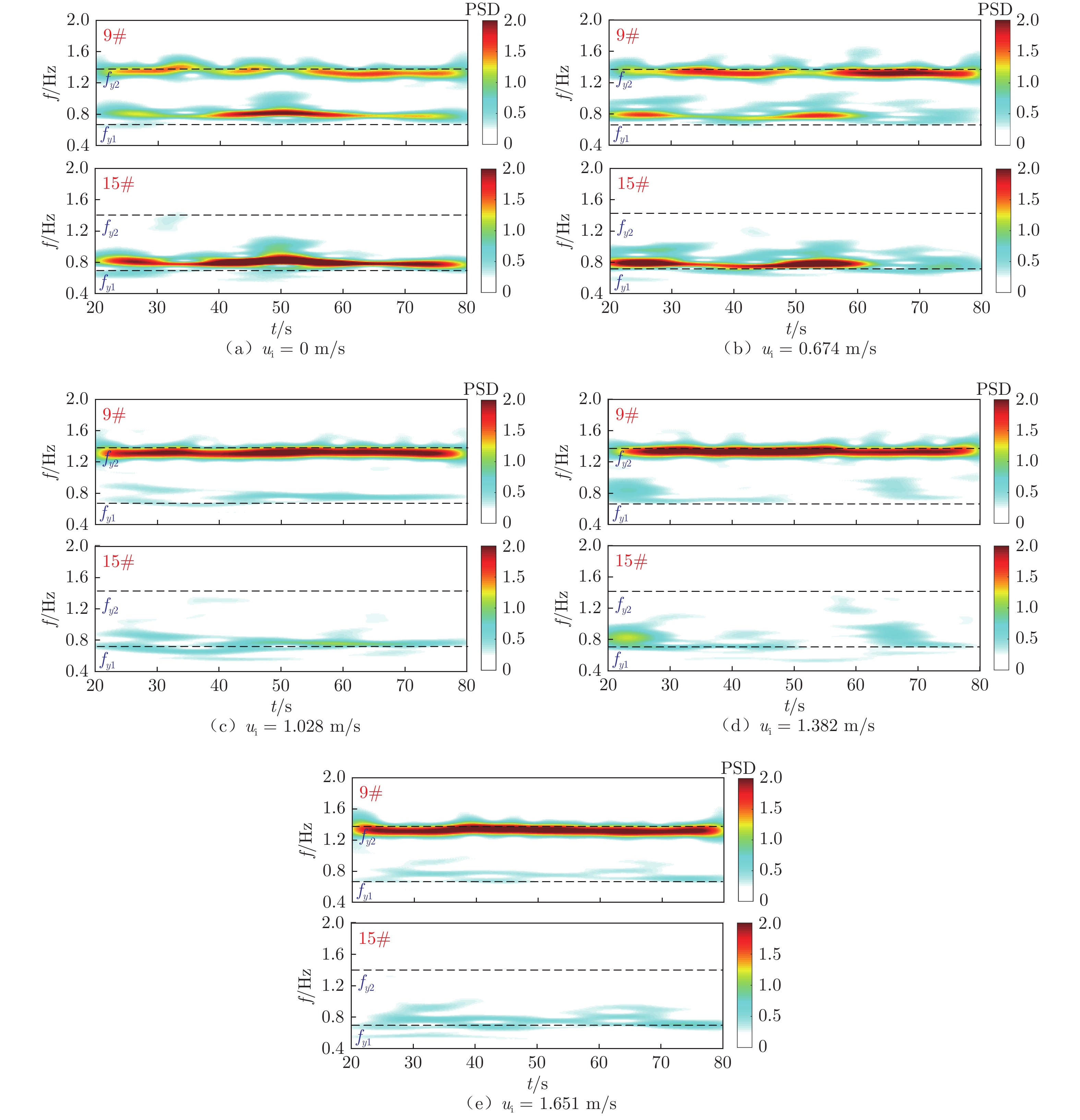Experimental investigation on the flow-induced vibration of a riser subjected to the combination of internal liquid flow and external sheared flow
-
摘要:
柔性立管广泛应用于海洋油气等矿产资源的输送,在内部流体与外部海流的夹击下极易产生复杂的振动响应,一旦发生疲劳失效,就会造成严重的环境污染。在循环水槽中开展了单相内流与非线性剪切外流耦合作用下悬链线型柔性立管的振动响应测试,采用高速摄像非介入测试方法捕捉了悬链线型柔性立管的振动位移。通过改变非线性剪切外流的约化速度($U_{\text{\,r}}^{\text{m}}$ = 3.55~44.69)和内流流速(ui = 0.674~1.651 m/s),分析了内流流速对柔性立管振动响应的影响规律,剖析了不同流动工况下平面外振幅、振频的时空响应特性及振动模态的演变。实验结果表明:与纯外流激发的涡激振动相比,内流的存在使柔性立管的振幅增大,且振动模态转换发生在更低的约化速度,随着内流流速的增大,相邻模态间发生模态转换的临界约化速度越来越低;在本实验测试工况下,当柔性立管在纯外流作用下发生锁频振动时,振动模态没有发生改变,而在外流涡激振动处于模态过渡区时,内流的输送易使高阶模态在更低的约化速度时出现。
Abstract:Flexible risers which are commonly applied to transport submarine resources have been widely utilized in offshore engineering. The intricate Flow-Induced Vibration (FIV) of flexible risers is easily encountered with the presence of both internal and external flows. Once the riser fatigue failure occurs, it causes serious environmental pollution. In this work, a series of tests were conducted in a recirculating water flume to investigate the dynamic behavior of a flexible catenary riser under the combination of the internal liquid water flow and the external shear current. A non-intrusive high-speed imaging technique was employed to record the vibration displacement varying along the riser span. The reduced velocity and the internal flow velocity ranged from 3.55 to 44.69 and from 0.674 m/s to 1.651 m/s, respectively. The influence of the internal flow velocity on the dynamic response was examined. The experimental results including the spatial-temporal response amplitude and frequency as well as the mode evolution of out-of-plane were analyzed. The results show that the response is enhanced with increasing internal flow velocity except for the mode transition cases. In addition, the existence of the internal flow leads to the earlier occurrence of the mode transition. When the lock-in occurs in the vortex-induced vibration of the flexible riser, the amplitude of the flexible riser is magnified with increasing internal velocity, while the new mode response is not triggered. There is a new mode response occurring in the mode transition cases.
-
-
图 6 $\text{U}_{\text{\,{{r}}}}^{\text{{{\,m}}}}$ = 3.55时不同内流流速作用下柔性立管展向的频率分布及典型位置的时频变化
Fig. 6 The power spectra density distribution along the flexible riser span and wavelet time-frequency contours at typical positions of flexible at $\text{U}_{\text{\,{{r}}}}^{\text{{{\,m}}}}$ = 3.55 coupled with different internal velocities
表 1 柔性立管模型参数
Table 1 Parameters of the flexible riser model
参数 数值 单位 长度l 1000 mm 水平跨长l0 690 mm 外径D 8 mm 壁厚δ 1 mm 长径比l/D 125 弹性模量E 7.15 × 106 N/m2 单位长度质量m 0.0256 kg/m 质量比m* 1.073 -
[1] HUERA-HUARTE F J, BEARMAN P W, CHAPLIN J R. On the force distribution along the axis of a flexible circular cylinder undergoing multi-mode vortex-induced vibrations[J]. Journal of Fluids and Structures, 2006, 22(6-7): 897–903. doi: 10.1016/j.jfluidstructs.2006.04.014
[2] CHAPLIN J R, BEARMAN P W, HUERA HUARTE F J, et al. Laboratory measurements of vortex-induced vibrations of a vertical tension riser in a stepped current[J]. Journal of Fluids and Structures, 2005, 21(1): 3–24. doi: 10.1016/j.jfluidstructs.2005.04.010
[3] LEE L, ALLEN D. Vibration frequency and lock-in bandwidth of tensioned, flexible cylinders experiencing vortex shedding[J]. Journal of Fluids and Structures, 2010, 26(4): 602–610. doi: 10.1016/j.jfluidstructs.2010.02.002
[4] BOURGUET R, KARNIADAKIS G E, TRIANTAFYLLOU M S. Vortex-induced vibrations of a long flexible cylinder in shear flow[J]. Journal of Fluid Mechanics, 2011, 677: 342–382. doi: 10.1017/jfm.2011.90
[5] BOURGUET R, KARNIADAKIS G E, TRIANTAFYLLOU M S. Distributed lock-in drives broadband vortex-induced vibrations of a long flexible cylinder in shear flow[J]. Journal of Fluid Mechanics, 2013, 717: 361–375. doi: 10.1017/jfm.2012.576
[6] BOURGUET R, KARNIADAKIS G E, TRIANTAFYLLOU M S. Multi-frequency vortex-induced vibrations of a long tensioned beam in linear and exponential shear flows[J]. Journal of Fluids and Structures, 2013, 41: 33–42. doi: 10.1016/j.jfluidstructs.2012.07.007
[7] BOURGUET R. Vortex-induced vibrations of a flexible cylinder at subcritical Reynolds number[J]. Journal of Fluid Mechanics, 2020, 902: R3. doi: 10.1017/jfm.2020.676
[8] LIN K, WANG J S. Numerical simulation of vortex-induced vibration of long flexible risers using a SDVM-FEM coupled method[J]. Ocean Engineering, 2019, 172: 468–486. doi: 10.1016/j.oceaneng.2018.12.006
[9] LUCOR D, IMAS L, KARNIADAKIS G E. Vortex dislocations and force distribution of long flexible cylinders subjected to sheared flows[J]. Journal of Fluids and Structures, 2001, 15(3-4): 641–650. doi: 10.1006/jfls.2000.0366
[10] SARPKAYA T. Vortex-induced oscillations: a selective review[J]. Journal of Applied Mechanics, 1979, 46(2): 241–258. doi: 10.1115/1.3424537
[11] VANDIVER J K, ALLEN D, LI L. The occurrence of lock-in under highly sheared conditions[J]. Journal of Fluids and Structures, 1996, 10(5): 555–561. doi: 10.1006/jfls.1996.0037
[12] GRIFFIN O M, RAMBERG S E. Some recent studies of vortex shedding with application to marine tubulars and risers[J]. Journal of Energy Resources Technology, 1982, 104(1): 2–13. doi: 10.1115/1.3230377
[13] VANDIVER J K. Dimensionless parameters important to the prediction of vortex-induced vibration of long, flexible cylinders in ocean currents[J]. Journal of Fluids and Structures, 1993, 7(5): 423–455. doi: 10.1006/jfls.1993.1028
[14] BOURGUET R, LUCOR D, TRIANTAFYLLOU M S. Mono- and multi-frequency vortex-induced vibrations of a long tensioned beam in shear flow[J]. Journal of Fluids and Structures, 2012, 32: 52–64. doi: 10.1016/j.jfluidstructs.2011.05.008
[15] NEWMAN D J, KARNIADAKIS G E. A direct numerical simulation study of flow past a freely vibrating cable[J]. Journal of Fluid Mechanics, 1997, 344: 95–136. doi: 10.1017/s002211209700582x
[16] GAO Y, ZHANG Z Z, ZOU L, et al. Effect of boundary condition and aspect ratio on vortex-induced vibration response of a circular cylinder[J]. Ocean Engineering, 2019, 188: 106244. doi: 10.1016/j.oceaneng.2019.106244
[17] DUAN J L, ZHOU J F, YOU Y X, et al. Effect of internal flow on vortex-induced vibration dynamics of a flexible mining riser in external shear current[J]. Marine Structures, 2021, 80: 103094. doi: 10.1016/j.marstruc.2021.103094
[18] GUO H Y, LOU M, DONG X L. Experimental study on vortex-induced vibration of risers transporting fluid[C]//Proc of the Sixteenth International Offshore and Polar Engineering Conference. 2006.
[19] GUO H Y, WANG S Q, WU L, et al. Dynamic characteristics of marine risers conveying fluid[J]. China Ocean Engineering, 2000, 14(2): 153–160.
[20] MENG S, ZHANG X Q, CHE C D, et al. Cross-flow vortex-induced vibration of a flexible riser transporting an internal flow from subcritical to supercritical[J]. Ocean Engineering, 2017, 139: 74–84. doi: 10.1016/j.oceaneng.2017.04.039
[21] CHEN Z S, KIM W J, XIONG C B. Effect of upward internal flow on dynamics of riser model subject to shear current[J]. China Ocean Engineering, 2012, 26(1): 95–108. doi: 10.1007/s13344-012-0007-3
[22] GUO H Y, LOU M. Effect of internal flow on vortex-induced vibration of risers[J]. Journal of Fluids and Structures, 2008, 24(4): 496–504. doi: 10.1016/j.jfluidstructs.2007.10.002
[23] ZHU H J, HU J, GAO Y, et al. Spatial-temporal mode transition in vortex-induced vibration of catenary flexible riser[J]. Journal of Fluids and Structures, 2021, 102: 103234. doi: 10.1016/j.jfluidstructs.2021.103234
[24] ZHU H J, GAO Y, ZHAO H L. Experimental investigation of slug flow-induced vibration of a flexible riser[J]. Ocean Engineering, 2019, 189: 106370. doi: 10.1016/j.oceaneng.2019.106370
[25] ZHU H J, GAO Y, ZHAO H L. Coupling vibration response of a curved flexible riser under the combination of internal slug flow and external shear current[J]. Journal of Fluids and Structures, 2019, 91: 102724. doi: 10.1016/j.jfluidstructs.2019.102724
[26] ZHU H J, LIN P Z, GAO Y. Vortex-induced vibration and mode transition of a curved flexible free-hanging cylinder in exponential shear flows[J]. Journal of Fluids and Structures, 2019, 84: 56–76. doi: 10.1016/j.jfluidstructs.2018.10.009
[27] FAN D X, WANG Z C, TRIANTAFYLLOU M S, et al. Mapping the properties of the vortex-induced vibrations of flexible cylinders in uniform oncoming flow[J]. Journal of Fluid Mechanics, 2019, 881: 815–858. doi: 10.1017/jfm.2019.738







 下载:
下载:
